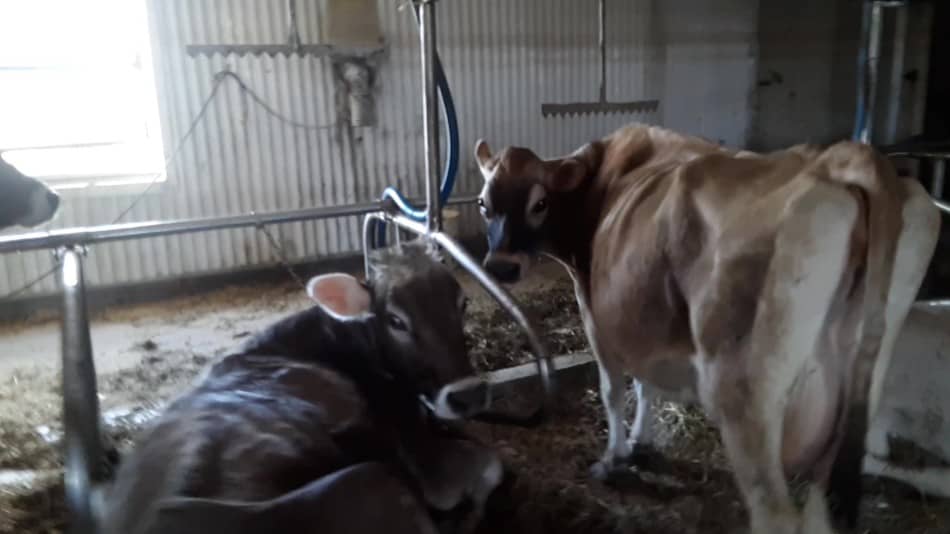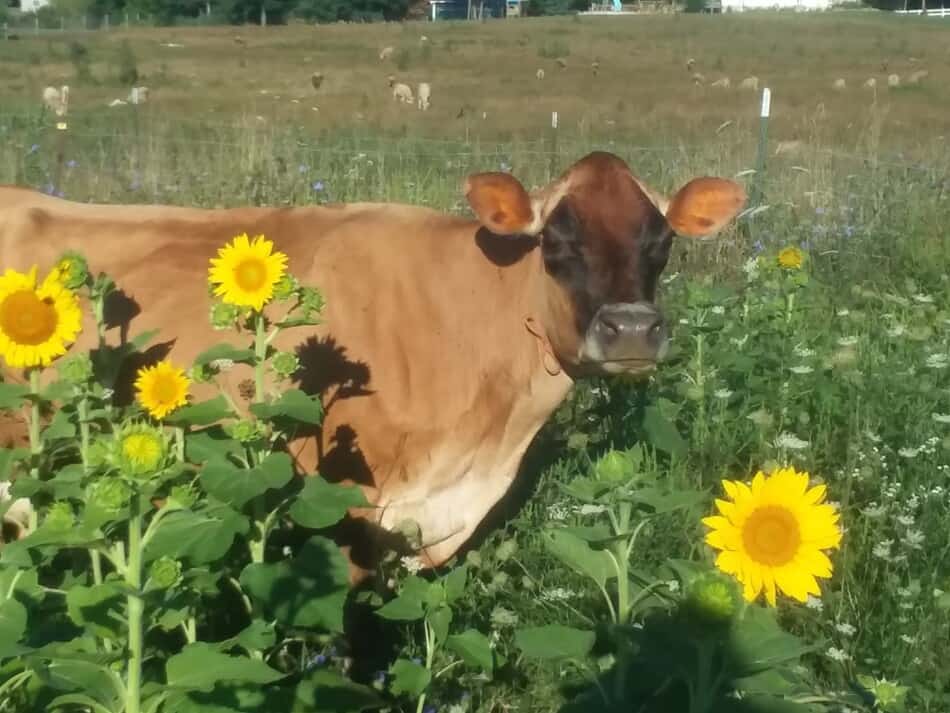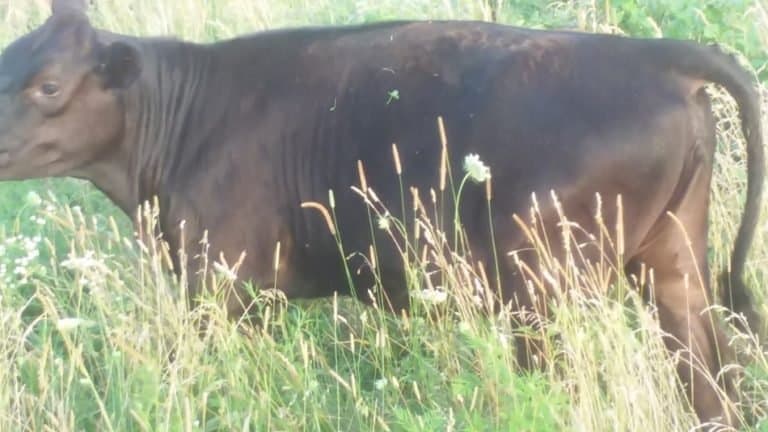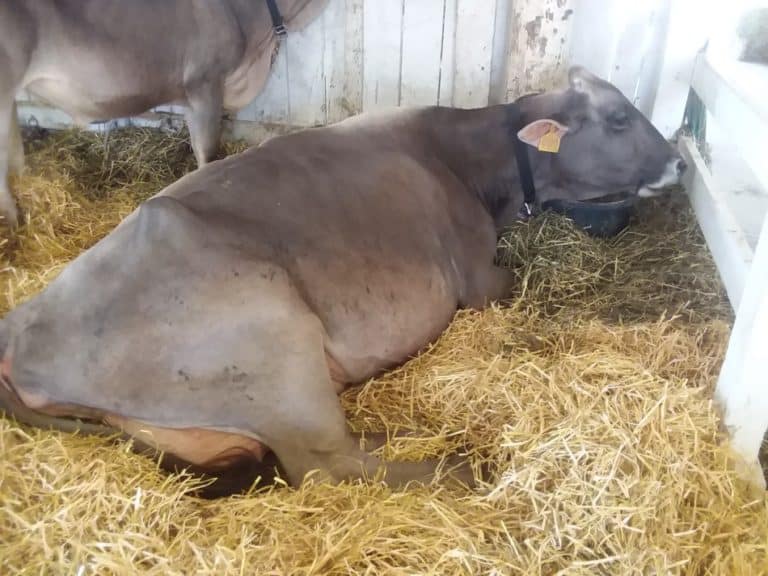Your Family Cow: When And How To Get Her Bred Back

You are living it up with drinking real milk, from your cow! By now you’ll have milking and daily routine completely figured out and adapted to your family’s needs.
Now you’ve got another task on your mind, or at least you should: getting her bred back. How do you do it and when is the right time?
Ideally, your cow should be bred back using natural service or artificial insemination during the third month of lactation to keep her calving at one year intervals. You can delay the breeding date to move the calving date to a more suitable time of year.
While getting your cow bred back is a pretty big deal, there are tons of people who get all of their cattle bred every year, so no worries.
With a little bit of time and planning, you can get your cow bred back, as well.
How do you know if you’re ready? My guide “Are You Ready For A Family Cow?” will walk you through the things you need to have figured out, including feeding needs and daily care, before you get your cow.
Cattle Reproduction Basics gives beginners the run down of the basic terminology we think you are going to come across when trying to figure out the best time to breed back your cow.
Breed back your cow in the 3rd month
As I mentioned above, the ideal time to get your cow bred back is in the third month of lactation.
This will keep her on a 12 month milk production cycle (a link to the last article I wrote), which is the ideal both in terms of her health and making sure there is plenty of milk for you.
You’ll want to breed her back three months after the date this year that you want her to calve on next year.
For example: if you want her to calve March next year, breed her in June this year.
Let me be clear, the 12 month milk production cycle is an ideal, not a have to. Cows can and do have calves throughout the year.
However, if the peak milk production time and a specific time of year need to coincide, like for grass based milk, you’ll need to keep her on schedule.
A match the cow’s needs to grass growth
Here is an example: Let’s say you want the majority of your cow’s milk production to be while she is eating grass, good call!
I want my cow to have tons of grass available to her when she is producing the most milk. We’ll use Ohio dates here, but adjust them to your area if this isn’t how it goes at your place.
Her highest milk production is going to be at 1.5-2 months fresh. Freshening is coming into milk production, after the calf is born.
Grass growth around here is at it’s best in May and June. Let’s put her peak milk production time at mid May.
For all this to coordinate (grass and cow), she would need to have her calf in late March or early April.
This means you’ll need to have her bred back in late June or early July.
Using Grass To Feed Your Herd shows you how to use your management to maximize grass growth for your cow.
Here are some of the average gestation lengths, by breed:
- Holstein 279
- Jersey 283 days
- Ayrshire 289 days
- Brown Swiss 291 days
The gestation length is based on 283 days from breeding.
Your Jersey will most likely be right on time with the gestation calculator, a Holstein will be earlier and most other breeds will be a bit later than the date given in the gestation calculator.
Don’t get too hung up on these specific figures, your cow doesn’t stick to the dates on the breeding calculator!
Consider the rest of the lactation timing
I would consider bumping that date up a bit, so that I would not have to milk in the really cold months of January and February.
To do this, I would want a bit earlier calving date, more towards the beginning of March.
This would have you drying her up around Christmas or the New Year and giving both of you two months vacation from milking. You’ll miss the milk, true, but she needs the time to rejuvenate.
Still a bit confused about the ideal calving time for your area ? Go with the dates that the deer of your area are having their fawns.
What ever time they have babies is the best time for your cow to have her baby.
You also have a limited amount of time to move the calving date up, so she would have a 11 month milk production cycle, if you were to get her bred back a month early.
Be careful here, she needs the rest period of being dry before the next calving and not all cows will breed back so quickly.
It will be much easier to push the calving date out further, for example: a 14 month milk production cycle, rather than go shorter than 12 months.
How do you know if you’re ready? My guide “Are You Ready For A Family Cow?” will walk you through the things you need to have figured out, including feeding needs and daily care, before you get your cow.
If she doesn’t breed back, keep milking her
For a while, nothing will happen. She’ll just keep milking. Some cows will milk for a few years between calves, this is a supply and demand thing, after all.
Eventually, she will go down in milk production to the point that it will not be worth your time to milk her twice a day. The beefier she is in build, the sooner this is likely to happen.
If your cow is very dairy in her build, you are not off the hook, she still needs to be bred back. You’ll just be more likely to have some wiggle room in the timing than someone with a chunkier cow.
The catch is: you don’t know how long your cow will milk per lactation until you test the limits.
This can go wobbly on you if she is one of those cows that automatically does the 12 month plan. Meaning, you’ll have a cow milking nearly nothing and have ages to wait until she freshens again.
Another concern for a cow that is not on a 12 month milk production cycle is keeping her at a healthy weight.
If you get your cow bred back really late, you’ll have a longer dry period, during which she’s still eating! Not just eating, overeating. Fat cows have more problems at birth.
Here’s a great overview article with a list of potential problem areas you should look into from Penn State Extension, Trouble Shooting Infertility Problems In Cattle.
Keeping your cow in great body condition helps her be at her best, which includes weight.
Is her hair shiny? If so, she’s looking good, if not adjust what she’s getting to eat.
Here’s an article in Hoard’s Dairyman about problems breeding back cows, is you want more of a commercial dairy answer.
Options for getting her bred back

Now that you know why you need to be paying attention to getting her bred back, we move to the how. As in how to get her bred back when you are a first time cow owner.
Using a bull to breed your milk cow
Good news, if you or a neighbor has beef cattle, use a bull. Obviously, the calf will be half beef, but that’s fine. We raise half beef calves all of the time and they do really well for us, even finishing on pasture.
One caution here: if you have a smaller framed cow, like a Jersey don’t turn her in with a mega sized beef bull.
You need a bull closer in size to your cow. The bull can be smaller than the cow, but not tons bigger than her, to avoid calving problems.
The only reason you’d need a 100% dairy genetics calf is to keep your next heifer. Don’t worry about that for now, your cow should last you for quite a few years, ours is 14 and still going strong!
Of course, if your neighbor has a dairy bull use it! But only if you like the bull and the rest of the cattle there. Otherwise, consider A.I.
Getting your cow bred back with A.I.
A.I. (when you are talking cattle) is artificial insemination. We have used A.I. for over 20 years.
Occasionally, we kept back a bull for the dairy herd, but usually we went with A.I.
Luckily for us, my husband does our A.I. work and always has. Luckily for you, tons of people use A.I. to get their cattle bred every year, all over the world.
Finding someone to A.I. your cow should not be a problem.
Wondering About A.I. For Your Cattle? goes over the things you need to know if you are considering using artificial insemination for your cow.
We use Select Sires to order straws of semen that we keep in the semen tank.
For the beginner, or just someone who needs A.I. done for them, Select Sires also has technicians that specialize in going to farms and getting cows bred for people.
I know in some areas of the country the vet does the family cow A.I. work. Super, that will work out great!
In our area, a vet normally does not do the A.I. Around here, techs are available who specialize in A.I. for anyone needing cattle bred, both beef and dairy.
12 Breeds For Family Cow goes over a variety pack of breeds to consider breeding your cow to. Crossbred cattle will grow better than purebreds and, in our experience, make wonderful cattle to work with.
How do you know if you’re ready? My guide “Are You Ready For A Family Cow?” will walk you through the things you need to have figured out, including feeding needs and daily care, before you get your cow.
Know when you cow is in standing heat
You’ll need to call the tech as soon as you know your cow is in heat, so he can work you into his daily schedule.
How do you tell if your cow is in heat? She will act oddly, maybe moo repeatedly a few times a day or hold her milk (not milk as much as usual).
If you have other cattle, identifying a standing heat in your cow is easy: the other cow/calf will ride her. You are looking for the cow on the bottom!
If your cow is riding the other cow/calf, your cow is either coming into heat or going out of heat.
When the other cow/calf is riding her, your cow is in standing heat. Standing heat is when she would stand for a bull, if you had one!

Keep track of all this information on a calendar! If you have been tracking her heat cycle up until now, when she comes into heat next will not be a surprise!
If, on the other hand, you have not been keeping track, this will catch you off guard and push back her next calving because you missed your window for this cycle.
Breeding back your cow is not a sure thing
You must watch your cow to make sure the breeding took!
All you need to do to keep your cow health and on track with her milk production is to monitor her hair coat. If she has shiny hair, she is doing well.
A happy cow that is in good shape will be more likely to breed back than a cow in poor shape. For clarity, poor shape can be too thin or too fat.
The easy answer here is to keep her in good shape. A healthy cow breeds back.
If your cows is not bred, fix her nutrition
When your cow is still open (not bred), you need to look for the mismatch in your husbandry and correct it.
Here are the things to look at:
- Her body condition
- Her nutrition
- Timing
Body condition should be ideal
How is her body condition? As we’ve talked about so far, both fat and thin can be problems for your cow.
If your cow is thin, yet being fed well, consider deworming her.
No matter how well you feed her, if she is chock full of intestinal worms they are stealing all of her nutrients.
She’s eating like crazy and those little monsters are living it up!
You’ve got to get rid of those parasites before your cow can get ahead on nutrition.
As long as the parasites are eating all of her food, she’s going to have a hard time breeding back.
Your cow’s nutrition will show in her hair
How is her nutrition? Is she shiny and happy? If not, adjust what you are doing. A healthy cow will breed.
Check out my article Family Cow Feeding Plan to figure out what you need to have on hand to keep your cow at her best.
Your cow should be able to fill up in an hour or two then spend the rest of the day laying down and chewing her cud. If your cow isn’t doing this, change something to help her.
If your pasture is not the greatest, have some supplemental hay available for her. If she needs it, she’ll grab some.
A great time for supplemental hay would be at milking, giving her another reason to like seeing you and the milk pail!
Timing of A.I. is crucial for your cow
Having the timing off is the most likely problem of all three listed. This is the reason why keeping track of her heat cycle on a calendar is crucial!
If she has a regular heat cycle and is in good condition, she should breed back.
If you’ve been keeping track of her heats for the past few months, you’ll be in a better position to set up the next year’s milk production cycle.
A second reason for keeping track of her heat cycle is to help the vet.
When you call the vet and ask for help, he is going to ask some basic questions, like heat cycle.
The more answers you have the more he can help you.
How do you know if you’re ready? My guide “Are You Ready For A Family Cow?” will walk you through the things you need to have figured out, including feeding needs and daily care, before you get your cow.
Resources:
ICBF (Irish Cattle Breeding Federation) Updated Gestation Length is the source of these gestation lengths.





